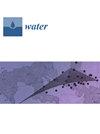On Internal Erosion of the Pervious Foundation of Flood Protection Dikes
IF 3
3区 环境科学与生态学
Q2 ENVIRONMENTAL SCIENCES
引用次数: 0
Abstract
This work focuses on the mechanisms that trigger internal erosion of the pervious foundation of flood protection dikes. The origin of these permeable layers is generally attributed to the presence of a paleo-valley and paleo-channels filled with gravelly-sandy sediments beneath the river bed and dikes. These layers may extend into the protected area. Visual observations of leaks, sand boils and sinkholes in the protected area testify to internal erosion processes in the underground soil. Local geological conditions are part of the information to be sought to explain these processes: presence of permeable soils and position of interfaces. Results obtained on Agly dikes (France), using two classical geophysical methods (EMI and ERT), were analyzed using cored soils and showed that it is not enough to simply conclude to the presence of backward erosion piping. The possibility of internal erosion, such as suffusion or contact erosion, must also be considered as the cause of leaks, sand boils and sinkholes. As the results obtained are explained by the presence of a paleo-valley and paleo-channels beneath the river bed and dikes—commonly encountered in this context—the methodology presented and the results obtained are likely to be relevant for many dikes.防洪堤透水地基内侵蚀问题研究
本研究的重点是引发防洪堤透水地基内部侵蚀的机制。这些可渗透层的形成通常归因于河床和堤防下存在充满砂砾质沉积物的古山谷和古河道。这些层可能延伸到保护区。在保护区内的渗漏、沙沸腾和天坑的目视观察证明了地下土壤的内部侵蚀过程。当地的地质条件是解释这些过程的信息的一部分:渗透性土壤的存在和界面的位置。用两种经典的地球物理方法(EMI和ERT)对Agly堤防(法国)的结果进行了分析,结果表明,简单地断定反向侵蚀管道的存在是不够的。内部侵蚀的可能性,如渗透或接触侵蚀,也必须考虑到泄漏,砂沸腾和天坑的原因。由于所得到的结果是由河床和堤防下面的古山谷和古河道的存在所解释的——在这种情况下经常遇到——所提出的方法和所得到的结果可能与许多堤防有关。
本文章由计算机程序翻译,如有差异,请以英文原文为准。
求助全文
约1分钟内获得全文
求助全文
来源期刊

Water
WATER RESOURCES-
CiteScore
5.80
自引率
14.70%
发文量
3491
审稿时长
19.85 days
期刊介绍:
Water (ISSN 2073-4441) is an international and cross-disciplinary scholarly journal covering all aspects of water including water science and technology, and the hydrology, ecology and management of water resources. It publishes regular research papers, critical reviews and short communications, and there is no restriction on the length of the papers. Our aim is to encourage scientists to publish their experimental and theoretical research in as much detail as possible. Full experimental and/or methodical details must be provided for research articles. Computed data or files regarding the full details of the experimental procedure, if unable to be published in a normal way, can be deposited as supplementary material.
 求助内容:
求助内容: 应助结果提醒方式:
应助结果提醒方式:


